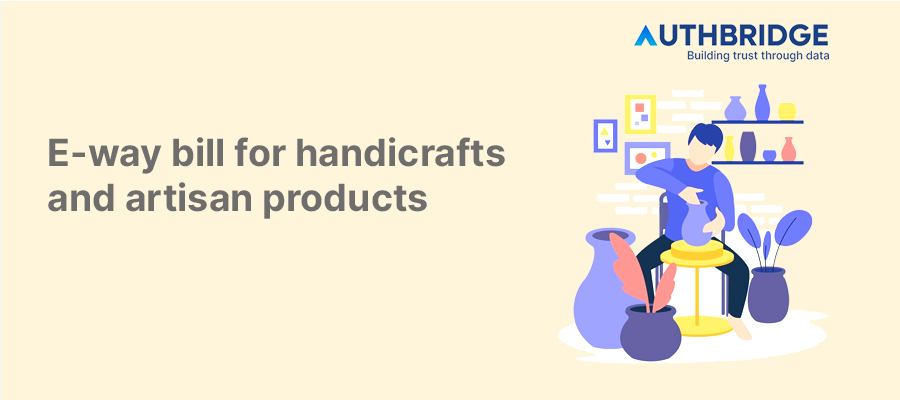Managing E-Way Bills For Handicrafts And Artisan Products

1. Introduction to E-Way Bill for Handicrafts and Artisan Products
Definition and Importance
E-Way Bills are electronic documents required for the interstate and intrastate transportation of goods in India, including handicrafts and artisan products. These items, often unique and of cultural significance, require careful handling and documentation to ensure compliance with GST regulations.
Overview of Legal Requirements
The legal framework for E-Way Bills, as outlined in the GST Act, mandates the generation of an E-Way Bill for the movement of goods exceeding a certain value threshold. For handicrafts, specific exemptions and requirements may apply, recognizing their unique nature and economic importance.
2. E-Way Bill Requirements for Handicraft Goods
Threshold Limits for Handicraft Goods
The threshold for E-Way Bill generation for handicraft goods may differ from other goods, with certain exemptions provided to promote the handicraft sector. It's crucial to stay updated on these limits to ensure compliance.
Documentation and Compliance for Interstate Movement
For the interstate movement of handicraft goods, documentation including GSTIN, details of the consignor and consignee, and the value of goods, must be meticulously maintained and reflected in the E-Way Bill.
3. Generating E-Way Bills for Handicrafts
Step-by-Step Process
- Login to the E-Way Bill Portal: Access the portal using your GST credentials.
- Enter Details: Include all required information, paying special attention to accurately describing the handicraft goods.
- Generate and Print: Once the E-Way Bill is generated, print a copy to accompany the goods during transportation.
Special Considerations for Artisan Products
Given the unique nature of artisan products, special care should be taken to accurately describe and value these items in the E-Way Bill to avoid disputes or compliance issues.
4. Challenges in Managing E-Way Bills for Handicrafts
Common Compliance Issues
Handicraft sellers often face challenges related to the accurate classification and valuation of their goods, leading to potential compliance issues.
Addressing Documentation and Valuation Challenges
Ensuring accurate documentation and valuation requires a thorough understanding of the goods being transported and the applicable GST regulations.
5. Best Practices in E-Way Bill Management for Handicrafts
Adopting best practices in E-Way Bill management ensures compliance and streamlines the process for businesses dealing in handicrafts and artisan products.
Accurate Classification and Valuation
Understanding the correct classification and valuation of handicraft items is crucial. This involves applying the right HSN codes and valuations that reflect the true nature and value of the goods.
Data Table: Classification and Valuation Best Practices
Best Practice | Description | Benefit |
Correct HSN Codes | Use appropriate HSN codes for handicraft items | Ensures compliance and accurate tax calculation |
Fair Valuation | Accurately value items based on material, labor, and other costs | Prevents disputes and penalties |
Leveraging Technology for Compliance
Technology plays a significant role in simplifying E-Way Bill management, making the process more efficient and less prone to errors.
Data Table: Technology Solutions for E-Way Bill Management
Technology Solution | Function | Benefit |
E-Way Bill Generation Software | Automates the creation of E-Way Bills | Reduces manual errors and saves time |
ERP Integration | Links E-Way Bill system with inventory and accounting software | Streamlines data flow and ensures accuracy |
6. Future Trends in Compliance for Handicrafts and Artisan Products
Staying ahead of technological advancements and regulatory changes is essential for businesses in the handicraft sector.
Technological Advancements
Emerging technologies like AI and blockchain are set to offer innovative solutions for E-Way Bill management, enhancing accuracy and efficiency.
Data Table: Emerging Technologies for E-Way Bill Management
Technology | Potential Application | Expected Benefit |
AI | Predictive analytics for logistics planning | Improved efficiency and compliance |
Blockchain | Secure and transparent record-keeping | Enhanced security and trust in transactions |
Regulatory Changes and Their Impact
Adapting to regulatory changes is crucial for maintaining compliance and supporting the growth of the handicraft industry.
Conclusion
Effective E-Way Bill management is vital for businesses dealing in handicrafts and artisan products, ensuring compliance with GST regulations while supporting efficient operations. By applying accurate classification and valuation, leveraging technology, and staying informed about future trends, businesses can navigate the complexities of E-Way Bill requirements successfully. These practices not only help in avoiding penalties but also contribute to the sustainable growth of the handicraft sector, preserving its cultural significance and economic value.
Category

Abhinandan Banerjee
(Associate Manager - Marketing)
Abhinandan is a dynamic Product and Content Marketer, boasting over seven years of experience in crafting impactful marketing strategies across diverse environments. Known for his strategic insights, he propels digital growth and boosts brand visibility by transforming complex ideas into compelling content that inspires action.



